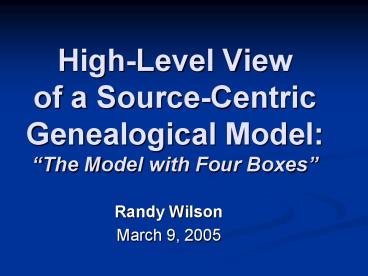High-Level View of a Source-Centric Genealogical Model: - PowerPoint PPT Presentation
Title:
High-Level View of a Source-Centric Genealogical Model:
Description:
... all extracted personas into the Family Tree. Verify that all of the above ... into their line in the Family Tree ... data into Family Tree for merging ... – PowerPoint PPT presentation
Number of Views:55
Avg rating:3.0/5.0
Title: High-Level View of a Source-Centric Genealogical Model:
1
High-Level Viewof a Source-CentricGenealogical
ModelThe Model with Four Boxes
- Randy Wilson
- March 9, 2005
2
Necessary Elements
- Source Authority
- Artifact Archive
- Structured Data Archive
- Family Tree
3
1. Source Authority
- List of all known potential sources of
genealogical data. - Assign unique ID to each source.
- Provide way to find existing sources
- Provide way to add new sources
- Assign unique id to each page of source
4
2. Artifact Archive
- Hold scanned images for
- each page of each source
- Uses id of page and source
- from Source Authority.
- Enables indexing or deep extraction over the
internet - Enables verification and permanent preservation.
5
3. Structured Data Archivea.k.a. Raw Data,
Source Data, Evidence Database, or
Extracted Records
- Accurately represent what a source says
- Has unique ID for each persona
(name/reference to a person) on each page. - Contains names, dates, place, relationships,
etc., that are clear from the source itself. - Could possibly contain certain
- low-level assertions.
6
Census Image
7
Extracted Data
8
4. Family Tree
- Represents our conclusions about who has lived
and how they are related. - Contains copies of information from the
extraction archive, along with persona IDs that
point to where the information came from. - Links personas from different records together
through relationships or merging/grouping.
9
To Do List
- Locate all sources in the world and add them to
the Source Authority. - Extract all genealogical data from all sources
(usually from scanned images). - Link all extracted personas into the Family Tree
- Verify that all of the above was done right
- Perform all ordinances.
10
Tasks for Users
- Enter what they know
- Extract/index data from images (perhaps in a
locality of interest to them) - Link extracted records into their line in the
Family Tree - Do verification work on extraction, linking.
- Take a name to the temple
11
Source Authority, contd
- List of all sources, including, for example
- Compiled family histories
- Records from courthouses and parishes
- Personal holdings (family bible, etc.)
- Cemeteries (pictures and/or transcriptions)
- Census records
- Memory of each user (i.e., personal knowledge)
12
Structured Data Archive
- Important for
- Computerized searching of data (traditional and
record linkage) - Pulling data into Family Tree for merging
(grouping/linking). - Knowing who on a page still needs work (and thus
which sources still need work). Avoid missing
people or repeating work forever. - Simpler browsing of sources than using images.
- Additional context (e.g., who lives next door)
13
Extraction Archive, contd
- Also
- Having intermediate step separates extraction
work from linking/merging work and other
conclusions. - This makes it simpler to verify each step.
- It also makes it more clear where differences of
opinion are coming from
14
Verification
- Currently thorough genealogists go back to the
original source to confirm anything they find in
an electronic database. - This would take each person forever on the Family
Tree. - We must store the fact that each step has been
verified so that eventually we can trust
well-verified work and move on to something else.
15
The Model with Four Boxes
Source / Evidence / Conclusions Record
collections / extracted records / people
16
Summary
- Source-centric approach allows completeness
without endless duplication of effort. - Users can participate in various activities, but
all of these can help move data from one point in
the process to the next. - Industry needs to think in a source-centric way
to enable true collaboration.
17
Questions?Ideas?
- E-mail wilsonr_at_ldschurch.org
- Blogs
- eatslikeahuman.blogspot.com
- source-centric-genealogy.blogspot.com































